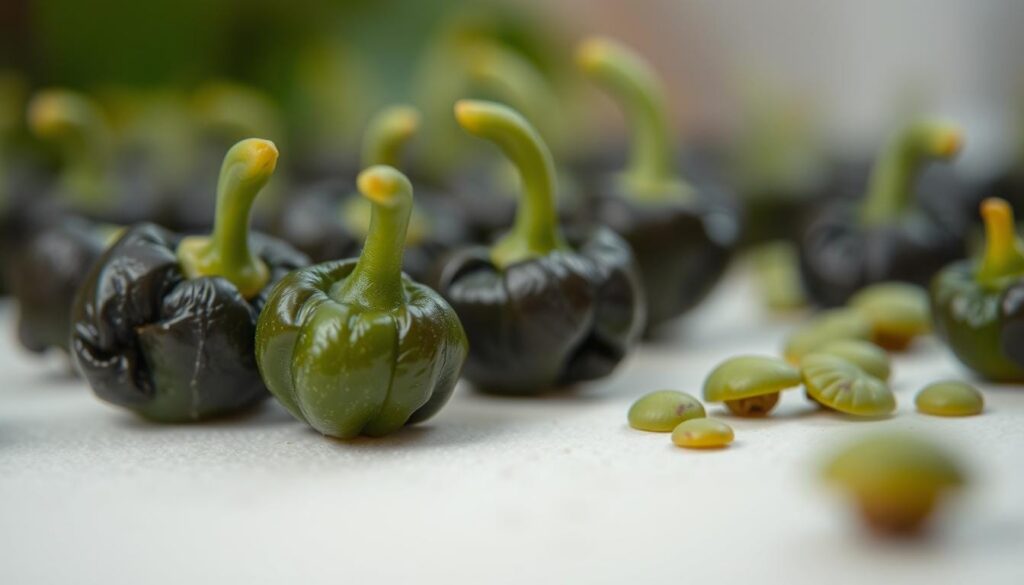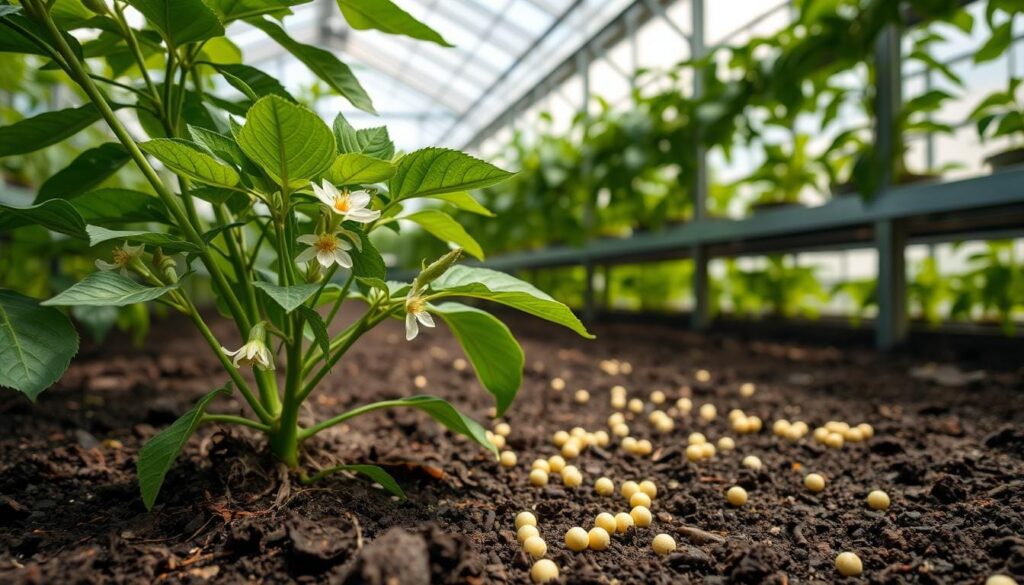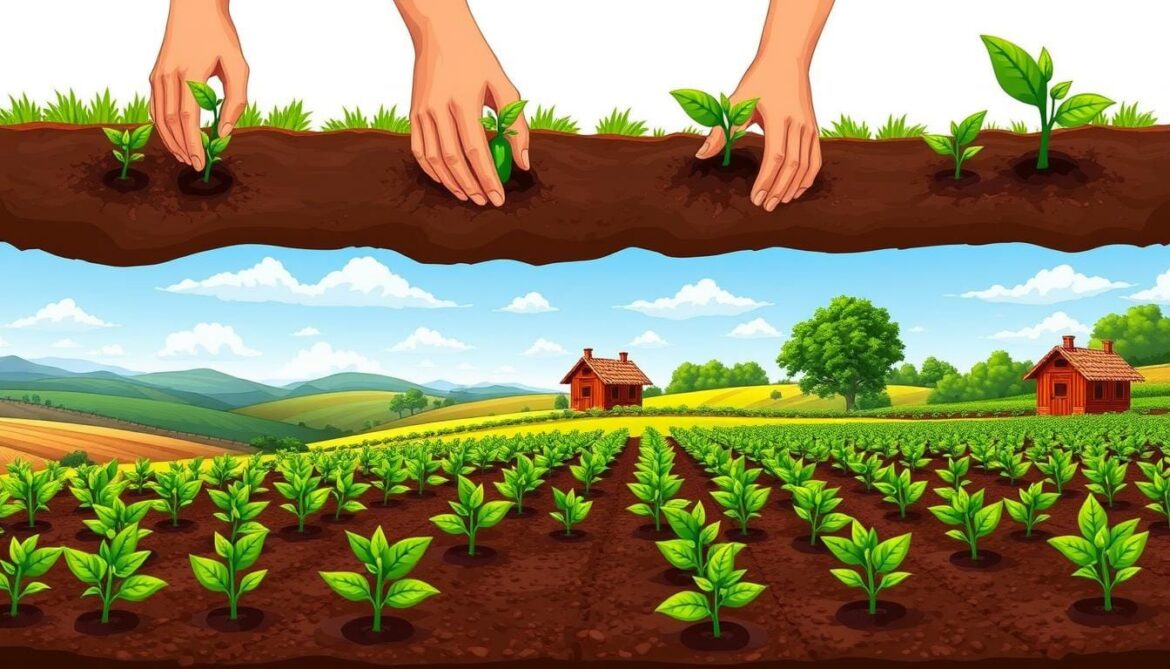Growing poblano peppers has been a passion of mine. I first tasted their rich, smoky flavor in a small Mexican restaurant. Transforming a tiny seed into a thriving pepper plant is magical.
Our guide will show you how to plant poblano peppers. It’s not just about following instructions. It’s about connecting with nature and growing your own food. Whether you’re new to gardening or experienced, our guide will help you grow these incredible peppers.
We’ll cover everything from choosing the right seeds to caring for your plants. With patience and care, you’ll soon harvest your own homegrown poblano peppers. They’ll be bursting with flavor.
Key Takeaways
- Poblano peppers originate from Puebla, Mexico
- They require warm soil temperatures between 80-90°F for germination
- Proper spacing between plants is key for healthy growth
- Consistent watering and well-draining soil are essential
- Harvest peppers when fully developed and firm
- Protect plants from temperatures below 60°F and above 90°F
Introduction to Poblano Peppers
Poblano peppers are a fascinating and versatile ingredient in Mexican cuisine. They have caught the attention of gardeners and food enthusiasts. As we explore these remarkable peppers, we’ll uncover what makes them unique in the world of growing poblano peppers.
What Are Poblano Peppers?
Poblano peppers come from Puebla, Mexico. They are part of the Capsicum annuum species. These heart-shaped fruits are 4 to 6 inches long and 2 to 3 inches wide. When growing poblano pepper seeds, gardeners will find a plant that is both versatile in the kitchen and beautiful in the garden.
Characteristics and Flavor Profile
Poblano peppers have unique characteristics:
- Mild heat level ranging from 1,000 to 2,000 Scoville Heat Units
- Rich, slightly earthy flavor profile
- Can be harvested green or red, with red peppers being slightly spicier
| Characteristic | Details |
|---|---|
| Plant Height | Up to 3 feet |
| Growing Temperature | 70°F to 85°F (daytime) |
| Nutritional Value | Low calories, rich in vitamins A and C |
When growing poblano peppers, gardeners find them adaptable and easy to care for. These peppers are perfect for both novice and experienced gardeners seeking a rewarding cultivation experience.
Choosing the Right Location
Growing poblano peppers needs careful thought about their growing conditions. These plants love the sun and need a good spot to grow well. This spot should help them grow big and give lots of peppers.
Poblano peppers need lots of sunlight to grow right. So, picking the right spot for your garden is key.
Sunlight Requirements
Poblano peppers need a lot of sunlight to grow well. Here are some sunlight tips:
- Minimum direct sunlight: 6-8 hours daily
- Ideal location: South-facing garden areas
- Avoid locations with significant shade
- Protect from intense afternoon heat in extremely hot regions
Soil Quality Considerations
Good soil is essential for healthy poblano pepper growth. Here are important soil tips:
- Soil pH range: 5.5-7.0 (slightly acidic to neutral)
- Soil texture: Sandy to loamy, well-draining
- Organic matter content: High
- Soil temperature: Consistently above 70°F (21°C)
Pro tip: Do a soil test before planting to make sure your poblano peppers have the best start.
Preparing the Soil for Planting
To create the perfect soil for poblano peppers, you need to know the basics of soil preparation. Our guide will show you how to give your peppers the best start.
Starting with good soil is key for growing poblano peppers. The right soil can greatly improve your pepper plant’s health and yield. Experts say a specific soil mix is for pepper plants.
Understanding Soil pH
Poblano peppers do best in certain soil conditions. Here’s what you should know about soil pH:
- Ideal pH range: 6.2 to 7.0
- Tolerable pH range: Up to 7.5
- Recommended testing method: Use a soil pH testing kit
Enhancing Soil with Organic Matter
Adding organic matter is vital for growing poblano peppers. Here’s a suggested soil mix:
| Soil Component | Percentage |
|---|---|
| Good garden soil | 1/3 |
| Composted cow manure | 1/3 |
| Sand | 1/3 |
Pro tip: Mix compost or aged compost into the top soil layer. This helps your peppers get the nutrients they need.
“The secret to great peppers is great soil” – Experienced Gardener
To improve your soil, add one teaspoon of sulfur per hole. This small step can really help your peppers grow better.
Selecting Seeds or Seedlings
Choosing between poblano pepper seeds and seedlings can greatly affect your gardening success. Each option has its own benefits for home gardeners wanting to grow these tasty peppers.
When picking poblano pepper seeds, you have many varieties to choose from. Some favorites include:
- Ancho Large Mexican
- Ancho Mulato
- Ancho Sweet Hybrid
Where to Buy Poblano Seeds
Finding good poblano pepper seeds takes some thought. Reliable seed suppliers like Baker Creek, Johnny’s Selected Seeds, and Burpee have quality seeds. Online stores and local garden shops are also great places to find them.
Sourcing Healthy Seedlings
For those wanting a quicker start, buying poblano pepper seedlings is a good choice. Look for seedlings with:
- Strong, vibrant green stems
- No signs of yellowing or wilting
- Healthy root system
- Height of 3-4 inches
The best time to start poblano pepper seeds indoors is about 8 weeks before the last frost. Seeds grow best at 80-90°F, taking 10-20 days to sprout. We suggest using a 50-cell or 72-cell tray for seedlings to grow well.
Pro tip: Keep the soil moist and warm for successful seed germination.
Whether you pick seeds or seedlings, with patience and care, you’ll enjoy a rich harvest of these tasty peppers.
Planting Timeframes for Poblano Peppers
Knowing when to plant poblano peppers is key for a great harvest. Our guide will show you the best times to plant these tasty Mexican peppers.
Planting poblano peppers needs careful timing and knowing your local weather. The success of your peppers depends on when you start seeds and transplant them.
Best Time to Start Seeds Indoors
Timing is everything when planting poblano peppers. Here are some tips for starting seeds indoors:
- Start seeds 6-8 weeks before the last frost date
- For colder areas (zones 4 and lower), start 8-10 weeks before last frost
- Keep soil warm, between 80-90°F, for seeds to germinate well
- Use grow lights for 14-16 hours a day to help seedlings grow
Transplanting Seedlings Outdoors
Knowing when to move seedlings outside is vital for strong plants. Here are some expert tips:
- Wait until it’s warm enough at night, above 55°F
- Move seedlings when their roots fill the starter pot
- Harden off seedlings for 2 weeks before moving them outside
- Make sure the soil is at least 65°F
Our planting schedule helps your poblano peppers get off to a great start. By following these tips, you’ll increase your chances of a big pepper harvest.
| Planting Stage | Recommended Timing | Key Considerations |
|---|---|---|
| Seed Starting | 6-8 weeks before last frost | Maintain 80-90°F soil temperature |
| Seedling Growth | 14-16 hours under grow lights | Ensure consistent moisture |
| Outdoor Transplanting | When nights stay above 55°F | Soil temperature must be 65°F+ |
Germination Process
Growing poblano peppers starts with understanding the critical germination process. Successful poblano pepper seeds need the right environment to sprout and grow. The journey from seed to seedling requires careful attention and specific care.

When starting poblano pepper seeds, temperature is key. Our research shows that seeds thrive best in soil temperatures between 75-85°F. Getting this temperature right can greatly improve germination rates.
Ideal Germination Conditions
- Maintain consistent soil temperature around 80-85°F
- Use a heat mat to regulate soil warmth
- Plant seeds approximately ¼ inch deep
- Keep soil consistently moist but not waterlogged
- Provide indirect light during germination
Common Germination Challenges
Growing poblano peppers from seeds can face several challenges. Pepper seeds usually take 2-3 weeks to germinate. But, many factors can slow down success.
- Temperature fluctuations: Can disrupt seed sprouting
- Inconsistent moisture levels
- Poor seed quality
- Inadequate light exposure
We suggest using fresh poblano pepper seeds and keeping the environment stable. This can help achieve a germination rate of 60-80%. Follow these guidelines carefully to increase your chances of success.
Transplanting Seedlings
Getting ready to move your poblano pepper seedlings outside is a big step. It’s important to make sure they do well in their new spot.
Before you move them, harden off your seedlings. This step helps them get used to the outdoors slowly. Start by letting them get some sun for 30 minutes a day. Then, little by little, increase the time they spend outside.
Safe Transplanting Techniques
Here’s how to safely move your poblano pepper seedlings:
- Wait until it’s warm enough, above 60°F (15°C)
- Find a spot that gets 6-8 hours of direct sunlight
- Make holes in the ground with some special soil
Spacing and Planting Guidelines
It’s important to space your plants right for them to grow well. Here’s a guide:
| Planting Location | Recommended Spacing |
|---|---|
| Garden Rows | 24-36 inches between rows |
| Individual Plants | 18-24 inches apart |
| Raised Beds | 14-16 inches between plants |
When you transplant, make holes a bit deeper than the roots. Burying them a bit deeper helps their roots grow. Add a little sulfur, sand, and compost to the hole for nutrients.
After you plant, put a 6-inch layer of mulch around the stem. This keeps the soil moist. Water well but don’t overdo it to avoid root rot.
Watering Techniques
Growing healthy poblano peppers needs the right poblano pepper watering instructions. It’s key to manage water well for strong plants and lots of peppers. Knowing how much water your plants need can greatly improve their health and how much they produce.
Our approach to watering poblano peppers is to keep the soil moist but not too wet. Gardening experts say it’s important to watch the soil moisture closely for the best growth.
Optimal Watering Frequency
Poblano pepper plants do best with a smart watering plan. Here are some tips for keeping them hydrated:
- Check soil moisture by touching the top inch of soil
- Water when the top layer feels dry to the touch
- During summer, water every other day
- In cooler conditions, reduce watering to once per week
Signs of Water Stress
It’s important to know when your poblano pepper plants are stressed from lack of water. Look out for these signs:
- Wilting leaves during peak sunlight hours
- Yellowing or browning leaf edges
- Stunted growth
- Drooping plant structure
Deep watering helps roots grow strong. Make sure water goes at least 6 inches deep into the soil. This helps plants grow strong and can handle hot and dry weather better.
Fertilization Strategies
To grow poblano peppers well, you need a good fertilization plan. It’s important to manage nutrients for strong plants and lots of fruit. We’ll show you the best ways to fertilize your poblano pepper garden.

Choosing the right fertilizer is key when growing poblano peppers. Use a balanced fertilizer that helps at all growth stages. The goal is to give nutrients without too much.
Recommended Fertilizer Types
- Organic fertilizers: Slow-release nutrients that improve soil structure
- Synthetic fertilizers: Provide immediate nutrient availability
- Balanced NPK fertilizers: Support overall plant health
Fertilization Frequency and Approach
Begin fertilizing poblano peppers 1-2 weeks after they start growing. Early on, use nitrogen-rich fertilizers for leaves and roots. Later, switch to a balanced fertilizer with less nitrogen.
| Growth Stage | Recommended NPK Ratio | Fertilization Frequency |
|---|---|---|
| Vegetative Stage | 11-5-5 | Weekly |
| Flowering Stage | 5-10-10 | Bi-weekly |
| Fruiting Stage | 2-3-1 | Every 2-3 weeks |
Look out for signs of nutrient problems or too much fertilizer. If leaves are pale, growth is slow, or leaves are burnt, it’s time to change your plan. Start small and add more as needed.
Application Tips for Growing Poblano Peppers
- Apply fertilizer directly to the soil
- Avoid contact with plant leaves
- Water thoroughly after fertilization
- Maintain soil pH between 5.8-6.8
By using these fertilization tips, you’ll grow healthy, productive poblano peppers. They’ll have plenty of delicious fruit.
Pest and Disease Management
Keeping your poblano pepper plants safe from pests and diseases is key to a healthy garden. Knowing the threats and taking steps early can help your plants grow well.
Managing your poblano pepper garden means fighting off common pests. Our guide will show you how to spot and fight these pests.
Common Pests in Poblano Pepper Gardens
- Aphids: Tiny insects that can spread viruses
- Spider mites: Tiny pests that harm leaves
- Flea beetles: Small bugs that make holes in leaves
- Thrips: Small insects that damage plant tissues
- Pepper weevils: A big problem in commercial pepper farms
Organic Pest Control Strategies
Using natural ways to fight pests can keep your plants safe without harsh chemicals. Here are some good methods:
- Use diatomaceous earth to kill larvae in the soil
- Plant different plants together to confuse pests
- Check your plants often for pests
- Keep the air around your plants dry to stop spider mites
- Keep new plants separate to stop pests from spreading
Disease Prevention Techniques
Keeping your poblano pepper plants safe from diseases needs careful watching and prevention. Watch out for:
- Bacterial leaf spot
- Mosaic virus
- Powdery mildew
- Southern blight
- Blossom end rot
Good soil, avoiding overhead watering, and choosing disease-resistant plants can help a lot. Regularly cleaning your garden, like removing dead leaves, makes it less welcoming to pests and diseases.
Harvesting Poblano Peppers
Growing poblano peppers needs careful attention to timing. Our guide will show you how to pick these tasty peppers with precision.
When planting poblano peppers, knowing when to harvest is key. These peppers take 65-75 days to mature. The right time to pick is when they’re at their best flavor and texture.
When to Harvest for Optimal Flavor
Poblano peppers can be picked at various stages. Each stage gives a different taste:
- Green poblanos: Pick when 4-6 inches long and shiny
- Red poblanos: Wait until they’re deep red for more sweetness
- Best time to pick: Just before they turn fully red for the best taste
Harvesting Techniques Without Plant Damage
Harvesting right protects your plants and keeps them producing. Follow these expert tips:
- Use sharp pruning shears or a clean knife
- Cut peppers carefully, leaving a short stem stub
- Avoid pulling or twisting, which can harm plant branches
| Pepper Stage | Characteristics | Scoville Heat Units |
|---|---|---|
| Green Poblano | Firm, glossy, 4-6 inches long | 1,000-1,500 SHUs |
| Red Poblano | Sweet, fully ripened | Around 1,000 SHUs |
Pro tip: Harvest in the morning when peppers are cool and crisp for the best quality.
“The secret to great poblano peppers is knowing exactly when to pick them.” – Southwestern Gardening Experts
Tips for Storing Poblano Peppers
After growing poblano peppers, it’s key to store them right to keep their taste and quality. You can keep fresh poblano peppers in the fridge for up to two weeks. Place them in a shallow container in the crisper drawer. Always check for mold or soft spots.
Freezing is great for keeping them for a long time. Cut the peppers into 1/2 inch wide and 2-3 inch long slices before freezing. This way, they can last up to a year. It’s ideal for enjoying your harvest all winter. Learn more about preserving your garden on gardening preservation methods.
Dehydrating is another good option. Use a temperature of 120°F to dry the peppers. They can last over a year if stored right. Pickling is also effective, keeping them good for 3-4 months in the fridge. Use a brine of vinegar, water, and salt.

